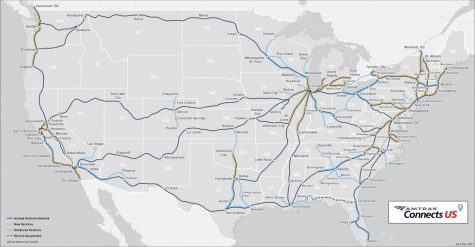Amtrak 2035 map revives hopes for a train from Iowa City to Chicago
A plan for an Amtrak Rail line from Chicago to Iowa City has been in the works for over 10 years but is being held up by funding problems. This line would make it easier for students at the University of Iowa to travel to and from Chicago.
Amtrak Guest Rewards loyalty program will have new rules starting Jan. 24.
April 15, 2021
Plans for an Amtrak station connecting Iowa City and Chicago have been revived in light of President Joe Biden’s proposed $2.2 trillion infrastructure bill.
Amtrak released a 15-year plan after Biden announced the infrastructure plan in late March, which includes expanded railways by the year 2035, including a stop in Iowa City.
This rail line would make it easier for students at the University of Iowa to travel from Chicago and the surrounding areas to get to Iowa City for school.
Brad Neumann, associate transportation planner at the Metropolitan Planning Organization of Johnson County, said the main motivation for these considerations is the potential for student use of the rail line.
“A large part of their [the UI’s] freshmen class every year is from Chicago, in that area. So, the idea was to serve mainly students between Chicago and Iowa City. And of course, you know, that means fewer vehicles on the interstates, on the roads. There’s a lot of positives to getting people off the road. And it goes mainly for the student population,” Neumann said.
Amtrak’s Vision for 2035 states that the company hopes to expand its services to over 160 more communities across the country, with multiple daily trips that would take place in 15 more states. Amtrak also hopes to potentially add more than 30 new routes while also trying to add more trips on more than 20 of the existing routes. The goal of this vision is to serve 20 million more passengers than the 32 million that were served through Amtrak in 2019.
Tara Pikey, a first-year psychology student at the UI, is from Downers Grove, Illinois, which is about 20 miles from Chicago. Pikey said this train would be beneficial to her in getting to and from school.
“I wouldn’t have to have someone come get me, it could just be my decision to come home,” Pikey said.
Pikey said right now, her way of getting to and from Iowa City is her parents. She said it is a six-hour round trip for them, so a train would be beneficial not only to her, but to her parents as well.

RELATED: Iowa City to consider eliminating fares for public transit
“I live about three hours away from Iowa City at the moment, so it is kind of sucky for my parents to have to drive me there and drop me off, because it’s a six hour drive for them,” Pikey said.
Conversations around an Amtrak rail line from Chicago to Iowa City have been going on for more than 10 years. These plans have largely been held up by a lack of funding in the Iowa Legislature.
In 2010, the Iowa and Illinois Departments of Transportation received a federal grant of $230 million for a rail between Chicago and Iowa City, with the rest of the funding to be made up by state appropriations.
Amanda Martin, the freight and passenger policy coordinator in the rail bureau of the Iowa DOT, said it was called an 80/20 grant, which means 80 percent of the funding comes from the federal government and has to be matched at 20 percent by state or local governments.
Martin said the rail line from Chicago to Moline, an Illinois city in the Quad Cities, is being handled by the Illinois DOT, but for the rail line from Moline to Iowa City, the Iowa DOT lacked funding for the final design and construction.
“All we have funding for is planning and some high-level engineering,” Martin said. “We do not have the funding to be able to do final design and construction, which would be the final phases to implement the service.”
Martin said that the state government did not approve the matching grant, which caused this project to come to a standstill.
“Typically, what happens is you go to the Legislature and ask for that match money, and if they support that, either through language that will appropriate that in the future, or some sort of funding opportunity in the immediate, then you can put that in your funding application and then move forward with a grant, if you received one from the federal government,” Martin said. “But if you do not have a match, then typically you’re kind of at a standstill, which is where we are.”



